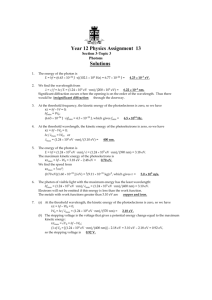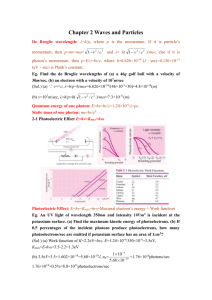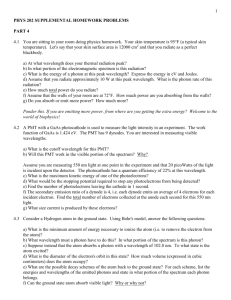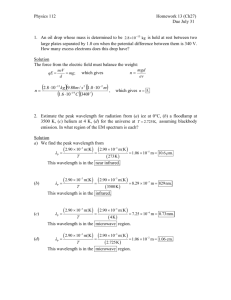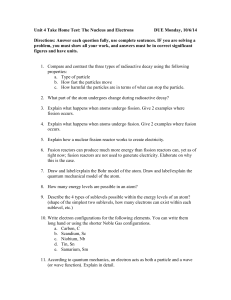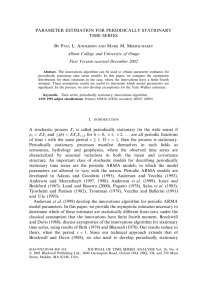Chapter 38
advertisement
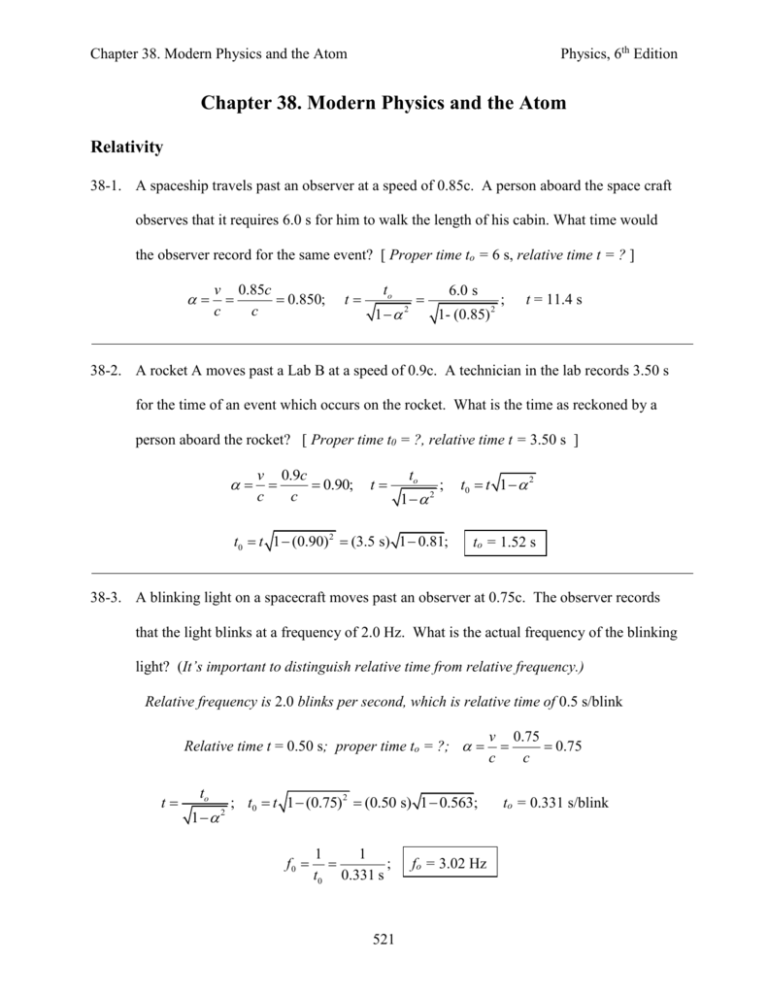
Physics, 6th Edition Chapter 38. Modern Physics and the Atom Chapter 38. Modern Physics and the Atom Relativity 38-1. A spaceship travels past an observer at a speed of 0.85c. A person aboard the space craft observes that it requires 6.0 s for him to walk the length of his cabin. What time would the observer record for the same event? [ Proper time to = 6 s, relative time t = ? ] v 0.85c 0.850; c c t to 1 2 6.0 s 1- (0.85) 2 ; t = 11.4 s 38-2. A rocket A moves past a Lab B at a speed of 0.9c. A technician in the lab records 3.50 s for the time of an event which occurs on the rocket. What is the time as reckoned by a person aboard the rocket? [ Proper time t0 = ?, relative time t = 3.50 s ] v c 0.9c 0.90; c t to 1 2 ; t0 t 1 (0.90) 2 (3.5 s) 1 0.81; t0 t 1 2 to = 1.52 s 38-3. A blinking light on a spacecraft moves past an observer at 0.75c. The observer records that the light blinks at a frequency of 2.0 Hz. What is the actual frequency of the blinking light? (It’s important to distinguish relative time from relative frequency.) Relative frequency is 2.0 blinks per second, which is relative time of 0.5 s/blink Relative time t = 0.50 s; proper time to = ?; t to 1 2 ; t0 t 1 (0.75) 2 (0.50 s) 1 0.563; f0 1 1 ; t0 0.331 s 521 fo = 3.02 Hz v 0.75 0.75 c c to = 0.331 s/blink Physics, 6th Edition Chapter 38. Modern Physics and the Atom 38-4. A particle on a table has a diameter of 2 mm when at rest. What must be the speed of an observer who measures the diameter as 1.69 mm? ( Proper length Lo = 2 mm. ) L2 L2 (1.69 mm) 2 2 2 1 ; 1 2 1 L20 L0 (2.00 mm) 2 L L0 1 ; 2 2 0.286; v 0.286 0.535; c v = 0.535c 38-5. A blue meter stick is aboard ship A and a red meterstick is aboard ship B. If ship A moves past B at 0.85c, what will be the length of each meterstick as reckoned by a person aboard ship A? (We must be careful to distinguish proper length from relative length.) Observer A sees blue stick as proper length Lo and red stick as relative length L. L r (1.00 m) 1 (0.85) 2 ; LB = 1.00 m; Lr = 52.7 cm 38-6. Three meter sticks travel past an observer at speeds of 0.1c, 0.6c, and 0.9c. What lengths would be recorded by the observer? (Proper lengths Lo are each 1.00 m) 0.1c = 0.1; c L r (1.00 m) 1 (0.1c) 2 ; Lr = 99.5 cm; 0.6c = 0.6; c L r (1.00 m) 1 (0.6) 2 ; Lr = 80.0 cm 0.9c = 0.9; c L r (1.00 m) 1 (0.9) 2 ; Lr = 43.6 cm 38-7. What mass is required to run about 1 million 100-W light bulbs for 1 year? Eo = moc2 = (1 x 106)(100 W)(86,400 s/d)(356 d/yr) = 3.154 x 1015 J/yr mo Eo 3.154 x 1015J ; c 2 (3 x 108m/s)2 522 mo = 35.0 g Physics, 6th Edition Chapter 38. Modern Physics and the Atom 38-8. Elementary particles called mu-mesons rain down through the atmosphere at 2.97 x 108 m/s. At rest the mu-meson would decay on average 2 s after it came into existence. What is the lifetime of these particles from the viewpoint of an observer on earth? 2.97 x 108 m/s 0.990; 3.00 x 108 m/s t to 1 2 2.0 s 1- (0.99) 2 ; t = 101 s The Photoelectric Effect 38-9. The first photoelectrons are emitted from a copper surface when the wavelength of incident radiation is 282 nm. What is the threshold frequency for copper? What is the work function for a copper surface? f0 c 0 (3 x 108 m/s) ; 282 x 10-9 m/s fo = 1.06 x 1015 Hz; W = hfo = (6.63 x 10-34 J/Hz)(1.06 x 1015 Hz); W = 7.028 x 10-19 J 1 ev W 7.03 x 1019 J ; -19 1.6 x 10 J W = 4.40 eV 38-10. If the photoelectric work function of a material is 4.0 eV, what is the minimum frequency of light required to eject photoelectrons? What is the threshold frequency? 1.6 x 10-19 J -19 W 4.0 eV 6.40 x 10 J; W hf 0 1 eV fo W 6.4 x 10-19 J ; h 6.63 x 10-34 J/Hz 523 f0 = 9.65 x 1014 Hz Physics, 6th Edition Chapter 38. Modern Physics and the Atom 38-11. The energy E of a photon in joules is found from the product hf. Often we are given the wavelength of light and need to find its energy in electron volts. Show that E 1240 such that if is in nanometers, E will be the energy in electron volts. E hc ; E hc (6.63 x 10-34 J/Hz)(3 x 108m/s) = 1.99 x 10-25 J m 1 ev 1 nm E (1.99 x 10-25 J m) ; -19 -9 1.6 x 10 J 1 x 10 m When is in nm , E will be in J: E = eVnm 1240 38-12. Use the equation derived in Problem 38-13 to verify that light of wavelength 490 nm has an energy of 2.53 eV. Also show that a photon whose energy is 2.10 eV has a wavelength of 590 nm. E 1240 1240 ; 490 nm E = 2.53 J; 1240 1240 ; E 2.10 eV = 590 nm *38-13. The threshold frequency for a certain metal is 2.5 x 1014 Hz. What is the work function? If light of wavelength 400 nm shines on this surface, what is the kinetic energy of ejected photoelectrons? W = hfo = (6.63 x 10-34 J/Hz)(2.5 x 1014 Hz); W = 1.66 x 10-19 J 1 ev W 1.66 x 1019 J ; -19 1.6 x 10 J W = 1.04 eV (6.63 x 10-34 J/Hz)(3 x 108 m/s) Ek W 1.66 x 10-19 J ; Ek = 3.31 x 10-19 J -9 400 x 10 m hc 1 ev E 3.31 x 1019 J ; Ek = 2.07 eV -19 1.6 x 10 J 524 Physics, 6th Edition Chapter 38. Modern Physics and the Atom *38-14. When light of frequency 1.6 x 1015 Hz strikes a material surface, electrons just begin to leave the surface. What is the maximum kinetic energy of photoelectrons emitted from this surface when illuminated with light of frequency 2.0 x 1015 Hz? Ek hf hf 0 h( f f 0 ); Ek (6.63 x 10-34 J/Hz)(2.0 x 1015 Hz 1.6 x 1015 Hz); 1 eV Ek 2.65 x 1019 eV ; -19 1.6 x 10 J Ek = 1.66 eV *38-15. The work function of nickel surface is 5.01 eV. If a nickel surface is illuminated by light of wavelength 200 nm, what is the kinetic energy of the ejected electrons? Ek hc W ; hc Ek (6.63 x 10-34 J/Hz)(3 x 108m/s) 9.945 x 10-19 J 6.22 eV (200 x 10-9 m) hc W 6.22 eV 5.01 eV; Ek = 1.21 eV *38-16. The stopping potential is a reverse voltage that just stops the electrons from being emitted in a photoelectric application. The stopping potential is therefore equal to the kinetic energy of ejected photoelectrons. Find the stopping potential for Problem 38-15. The kinetic energy of the emitted electrons in Prob. 38-15 is 3.31 x 10-19 J (See above.) Ek qVs (1e)Vs ; Vs Ek 3.31 x 10-19 J ; Vs = 2.07 V (1e) 1.6 x 10-19C Waves and Particles 38-17. What is the de Broglie wavelength of a proton (m = 1.67 x 10-27 kg) when it is moving with a speed of 2 x 107 m/s? h (6.63 x 10-34 J/Hz) ; mv (1.67 x 10-27 kg)(2 x 107 m/s) 525 = 1.99 x 10-14 m Physics, 6th Edition Chapter 38. Modern Physics and the Atom 38-18. The de Broglie wavelength of a particle is 3 x 10-14 m. What is its momentum? 6.63 x 10-34 J/Hz mv ; 3 x 10-14 m h p = 2.21 x 10-20 kg m/s mv = p; 38-19. Recalling formulas for kinetic energy and momentum, show that for non-relativistic speeds, the momentum of a particle can be found from p 2mEk where Ek is the kinetic energy and m is the mass of the particle. p mv; p v ; m 2 mv 2 m p p2 Ek ; 2 2 m 2m p 2mEk *38-20. Determine the kinetic energy of an electron if its de Broglie wavelength is 2 x 10-11 m. h h 6.63 x 10-34 J/Hz ; v ; mv m (9.1 x 10-31kg)(2 x 10-11m) v 3.64 x 107 m/s Since v << c, we consider v to be nonrelativistic, Ek = ½mv2 = ½(9.1 x 10-31 kg)(3.64 x 107 m/s)2; Ek = 6.03 x 10-16 J If we consider effects of relativity, m0 Ek (m mo )c 2 mo c 2 6.10 x 10-16 J 2 1 So you can see that that the nonrelativistic value is not much off the mark. *38-21. What is the de Broglie wavelength of the waves associated with an electron that has been accelerated through a potential difference of 160 V? p 2mEk 2m(qV ); p 6.83 x 10-24 kg m/s; (See Prob. 38-19) p 2(9.1 x 10-31kg)(1.6 x 10-19C)(160 V) h 6.63 x 10-34 J/Hz ; p 6.83 x 10-24 kg m/s 526 = 9.71 x 10-11 m Physics, 6th Edition Chapter 38. Modern Physics and the Atom *38-22. The charge on a proton is +1.6 x 10-19 C and its rest mass is 1.67 x 1027 kg. What is the de Broglie wavelength of a proton if it is accelerated from rest through a potential difference of 500 V? p 2mEk 2m(qV ); p 2(1.67 x 10-27 kg)(1.6 x 10-19C )(500 V) p 5.17 x 10 kg m/s; h 6.63 x 10-34J/Hz ; p 5.17 x 10-22kg m/s -22 = 1.28 pm Atomic Spectra and Energy Levels 38-23. Determine the wavelength of the first three spectral lines of atomic hydrogen in the Balmer series. (For the Balmer series, n = 2. The first three lines come for ni =3, 4, and 5.) 1 1 R 2 2 ; 2 ni 1 (ni = 3, 4, and 5) (a) 1 1 1 (1.097 x 107 m -1 ) 2 ; 4 3 = 656.3 nm (ni = 3) (b) 1 1 1 (1.097 x 107 m-1 ) 2 ; 4 4 = 486.2 nm (ni = 4) (c) 1 1 (1.097 x 107 m-1 ) 2 ; 4 5 = 434.1 nm (ni = 5) 1 38-24. Find the wavelengths of the first three lines of atomic hydrogen in the Paschen series. (a) 1 1 1 (1.097 x 107 m-1 ) 2 ; 9 4 = 1887 nm (ni = 4) (b) 1 1 1 (1.097 x 107 m -1 ) 2 ; 9 5 = 1290 nm (ni = 5) (c) 1 1 (1.097 x 107 m-1 ) 2 ; 9 6 = 1101 nm (ni = 6) 1 527 Physics, 6th Edition Chapter 38. Modern Physics and the Atom 38-25. Determine the radius of the n = 4 Bohr level of the classical Bohr hydrogen atom. n2 0 h2 (4)2 (8.85 x 10-12C2 /N m2 )(6.63 x 10-34 J/Hz)2 r ; r = 847 pm me2 (9.1 x 10-34 J/Hz)(1.6 x 10-19C ) 38-26. What is the classical radius of the first Bohr orbit in the hydrogen atom? r n2 0 h2 (1)2 (8.85 x 10-12C2 /N m2 )(6.63 x 10-34 J/Hz)2 ; r = 53.2 pm me2 (9.1 x 10-34 J/Hz)(1.6 x 10-19C) 38-27. Determine the wavelength of the photon emitted from a hydrogen atom when the electron jumps from the n = 3 Bohr level to ground level. 1 1 1 1 R 2 2 (1.097 x 107 m-1 ) 2 2 ; 1 3 2 ni 1 = 102.6 nm *38-28. What is the maximum wavelength of an incident photon if it can ionize a hydrogen atom originally in its second excited state (n = 3)? Ionization Energy: E3 13.6 eV 13.6 eV ; n2 32 E3 1.511 eV 2.42 x 10-19 J hc (6.63 x 10-34 J/Hz)(3 x 108m/s) ; E3 2.42 x 10-19 J = 823 nm *38-29. What are the shortest and longest possible wavelengths in the Balmer series? (Since E=hc/, the highest energy (greatest n level) is shortest wavelength and vice versa.) Shortest , ni = : 1 1 1 (1.097 x 107 m-1 ) 2 ; 2 = 365 nm Longest , ni = 3: 1 1 (1.097 x 107 m -1 ) 2 2 ; 2 3 = 656 nm 1 528 Physics, 6th Edition Chapter 38. Modern Physics and the Atom Challenge Problems 38-30. At a cost of 9 cents per kWh, what is the cost of the maximum energy to be released from a 1-kg mass? Eo = moc2 = (1 kg)(3 x 108 m/s)2; Cost Eo = 9 x 1016 J $0.09 1 kWh (9 x 1016 J); Cost = 2.25 x 109 dollars 6 kWh 3.6 x 10 J 38-31. An event that occurs on a spaceship traveling at 0.8c relative to the earth is observed by a person on the ship to last for 3 s. What time would be observed by a person on the earth? How far will the person on earth judge that the spaceship has traveled during this event? Proper time is 3.0 s. t s = vto = (0.8c)to ; to 1 2 3.0 s 1- (0.8) 2 s = (0.8)(3 x 108 m/s)(5.0 s); ; t = 5.00 s s = 1.20 x 109 m 38-32. When monochromatic light of wavelength 450 nm strikes a cathode, photoelectrons are emitted with a velocity of 4.8 x 105 m/s. What is the work function for the surface in electronvolts? What is the threshold frequency? Ek ½ mv 2 ½(9.1 x 10-31kg)(4.8 x 105 m/s) 2 ; W hc Ek Ek 1.05 x 10-19 J (6.63 x 10-34 J/Hz)(3 x 108 m/s) 1.05 x 10-19 J; W = 3.37 x 10-19 J -9 450 x 10 m W hf0 ; f0 W 3.37 x 10-19 J ; h (6.63 x 10-34 J/Hz) fo = 5.09 x 1014 Hz In terms of electron-volts: Ek = 0.656 eV; 529 W = 3.18 eV Physics, 6th Edition Chapter 38. Modern Physics and the Atom 38-33. In the hydrogen atom an electron falls from the n = 5 level to the n = 2 level and emits a photon in the Balmer series. What is the wavelength and energy of the emitted light? 1 1 (1.097 x 107 m -1 ) 2 2 ; 2 5 1 (6.63 x 10-34 J/Hz)(3 x 108m/s) ; E 434 x 10-9 m hc = 434 nm E = 4.58 x 10-19 J or 2.86 eV 38-34. Calculate the frequency and the wavelength of the H line of the Balmer series. The transition is from the n = 4 level of the Bohr atom. 1 1 (1.097 x 107 m -1 ) 2 2 ; 2 4 1 f c (3 x 108 m/s) ; 486 x 10-9 m = 486.2 nm (ni = 4) f = 6.17 x 1014 Hz 38-35. A spaceship A travels past another ship B with a relative velocity of 0.2c. Observer B determines that it takes a person on ship A exactly 3.96 s to perform a task. What time will be measured for the same event by observer A? (Event happens aboard A) Observer A records proper time to; Observer B records relative time t = 3.96 s. t to 1 2 ; t0 t 1 (0.20)2 (3.96 s) 1 0.04; to = 3.88 s *38-36. The rest mass of an electron is 9.1 x 10-31 kg. What is the relativistic mass of an electron traveling at a speed of 2 x 108 m/s? What is the total energy of the electron? What is its relativistic kinetic energy? mo 2 x 108 m/s 1 kg 0.667; m ; 8 3 x 10 m/s 1 2 1 (0.667) 2 530 m = 16.4 x 10-31 kg Physics, 6th Edition Chapter 38. Modern Physics and the Atom E = mc2 = (16.4 x 10-31 kg)(3 x 108 m/s)2; *38-36. (Cont.) Ek = (m – mo)c2; E = 1.47 x 10-13 J Ek = (16.4 x 10-31 kg – 9.1 x 10-31 kg) (3 x 108 m/s)2; Ek = 6.57 x 10-14 J *38-37. What is the de Broglie wavelength of an electron whose kinetic energy is 50 MeV? 1.6 x 10-13J p 2 -12 Ek 50 MeV 8.00 x 10 J; Ek ½ mv ; v m 1 MeV 2 p Ek ½ m ; p 2mEk 2(9.1 x 10-31kg)(8 x 10-12 J); m p 3.82 x 10-21kg m/s; h 6.63 x 10-34J/Hz ; p 3.82 x 10-21kg m/s = 0.174 pm *38-38. The rest mass of a proton is 1.67 x 10-27 kg. What is the total energy of a proton that has been accelerated to a velocity of 2.5 x 108 m/s? What is its relativistic kinetic energy? 2 x 108 m/s 2 x 108 m/s 0.667; 0.833; 3 x 108 m/s 3 x 108 m/s E mo c 2 1 (0.833) Ek = E - moc2; 2 (1.67 x 10-27 kg)(3 x 108 m/s) 2 ; 0.553 E = 2.72 x 10-10 J Ek =2.72 x 10-10 J – (1.67 x 10-27 kg)(3 x 108 m/s)2; Ek = 1.22 x 10-10 J *38-39. Compute the mass and the speed of protons having a relativistic kinetic energy of 235 MeV. The rest mass of a proton is 1.67 x 10-27 kg. 1.6 x 10-13J -11 Ek 235 MeV 3.76 x 10 J; 1 MeV 3.76 x 10-11J m 1.67 x 10-27 kg; 8 2 (3 x 10 m/s) 531 Ek mc 2 mo c 2 ; m m = 2.09 x 10-27 kg Ek m0 c2 Physics, 6th Edition Chapter 38. Modern Physics and the Atom *38-39. (Cont.) m m0 1 2 ; 1- 2 2 m 1- 2 0 ; m m0 ; m m0 m 2 2 1 2 1.67 x 10-27 kg 1 ; -27 2.09 x 10 kg 0.362 0.601; 2 v c ; v c (0.601)(3 x 108 m/s); v = 1.80 x 108 m/s *38-40. How much work is required to accelerate a 1-kg mass from rest to a speed of 0.1c? How much work is required to accelerate this mass from an initial speed of 0.3c to a final speed of 0.9c? (Use the work-energy theorem.) Recall that for nonrelativistic speeds: Work = ½mvf2 - ½mvo2 Work = ½(1 kg)(0.1c)2 – 0; Work = 4.50 x 1014 J Now, consider the relativistic speeds and final and initial Ek’s based on ’s: f vf c ; Ekf m0c 2 1 2 f o m0c 2 ; v0 ; c Ek 0 m0c 2 1 2 0 m0c 2 ; m c2 m c2 Work Ek 0 m0c 2 0 m0c 2 1 2f 1 02 Work = Ef - Eo eliminates moc2 terms: Ek f vf Ek c 0.9c 0.9; 2f 0.81; c 0 m0c 2 1 2f m0c 2 1 02 v0 0.3c 0.3; 02 0.09 c c m0c 2 m0c 2 2.294m0c 2 1.05m0c 2 ; Ek 1.25m0c 2 1 0.81 1 0.09 Ek 1.25m0 c 2 1.25(1 kg)(3 x 108 m/s) 2 ; 532 Work = Ek = 1.12 x 1017 J Physics, 6th Edition Chapter 38. Modern Physics and the Atom *38-41. A particle of mass m is traveling at 0.9c. By what factor is its relativistic kinetic energy greater than its Newtonian kinetic energy? (First ignore effects of relativity) Ek = ½mov2 = ½mo(0.9c)2 ; 2 0.9c 0.81; c 2 Ek ratio Ek = 0.405moc2 Now with relativity: m0 c 2 m0 c 2 2.294m0 c 2 m0c 2 ; Ek 1.294m0c 2 1 0.81 Erel 1.294m0c 2 ; E0 0.405m0c 2 ratio = 3.20 *38-42. What is the momentum of a 40-eV photon? What is the wavelength of an electron with the same momentum as this photon? E (40 eV)(1.6 x 10-19J/eV) E pc; p ; c (3 x 108m/s) h (6.63 x 10-34 J/Hz) ; p 2.13 x 10-26kg m/s p = 2.13 x 10-26 kg m/s = 31.1 nm *38-43. When monochromatic light of wavelength 410 nm strikes a cathode, photoelectrons are emitted with a velocity of 4.0 x 105 m/s. What is the work function for the surface and what is the threshold frequency? Ek ½ mv 2 ½(9.1 x 10-31kg)(4 x 105 m/s) 2 ; W hc Ek (6.63 x 10-34 J/Hz)(3 x 108 m/s) 7.28 x 10-20 J = 4.12 x 10-19 J; 410 x 10-9 m 1 eV W 4.12 x 1019 ; -19 1.6 x 10 J W hf0 ; Ek 7.28 x 10-20 J W 4.12 x 10-19 J f0 ; h (6.63 x 10-34 J/Hz) 533 W = 2.58 eV fo = 6.23 x 1014 Hz Physics, 6th Edition Chapter 38. Modern Physics and the Atom *38-44. What is the velocity of a neutron (m = 1.675 x 10-27 kg) that has a de Broglie wavelength of 0.1 nm. What is its kinetic energy in electronvolts? h (6.63 x 10-34 J/Hz) ; v m (1.675 x 10-27 kg)(0.1 x 10-9m) h ; mv Ek = ½(1.675 x 10-27 kg)(3960 m/s)2 ; v = 3960 m/s Ek = 1.31 x 10-20 J *38-45. What is the velocity of a particle whose relativistic kinetic energy is twice its rest mass [ Note: The conditions are that Ek(rel.) = 2moc2 ] energy? mc2 – moc2 = 2moc2; (m - mo)c2 =2moc2; m0 1 2 3m0 ; 1 1- 2 ; 3 v 0.889; c mc2 = 3moc2; m = 3mo 1 1- 2 ; 2 1 0.111; 9 v 0.943c; v = 2.83 x 108 m/s *38-46. Compute the relativistic mass and the speed of electrons having a relativistic kinetic energy of 1.2 MeV. 1.6 x 10-13J -13 Ek 1.20 MeV 1.92 x 10 J; 1 MeV m m Ek mc 2 moc 2 ; m 1.92 x 10-13J 9.1 x 10-31kg; (3 x 108 m/s)2 m0 1 2 ; m = 3.04 x 10-30 kg 2 m 1- 0 ; m m 1- 0 ; m 2 2 m 1 0 m 2 2 9.1 x 10-31kg 1 ; -30 3.04 x 10 kg 2 v c ; 0.910 0.954; v c (0.954)(3 x 108 m/s); 534 Ek m0 c2 v = 2.86 x 108 m/s 2 Physics, 6th Edition Chapter 38. Modern Physics and the Atom Critical Thinking Problems 38-47. A blue spacecraft is traveling at 0.8c relative to a red spacecraft. On the blue ship, a person moves a blue block a distance of 8 m in 3.0 s. On the red ship, a person moves a red block a distance of 4 m in 2.0 s. (a) What are the measurements of these four parameters from the viewpoint of the person on the blue ship? (b) What are the same measurements from the perspective of a person on the red ship? [ = 0.8c/c = 0.800 ] For person on blue craft, all blue measurements are proper and red values are relative: Lb = 8.00 m; Lr Lor 1 (0.8) 2 (4 m)(0.6); Lr = 2.40 m tb = 3.00s; tr t0 r 1 (0.8) 2 2.0 s ; 0.6 tr = 3.33 s For person on red craft, all red measurements are proper and blue values are relative: Lr = 4.00 m; Lb Lob 1 (0.8) 2 (8 m)(0.6); Lb = 4.80 m tr = 2.00s; tb t0 b 1 (0.8) 2 3.0 s ; 0.6 tb = 5.00 s *38-48. Use the work-energy theorem to compare the work required to change relativistic speeds with the values obtained from Newtonian physics. (a) The speed of a 1 kg mass changes from 0.1c to 0.2c? (b) The speed changes from 0.7c to 0.8c? Newtonian work Ek ½ mvv2 ½ mv02 Relativistic work Ek m0c 2 1 2f m0c 2 1 02 ; ( See Problem 38-40 ) (a) Newtonian Work ½(1 kg)(0.2c)2 ½(1 kg)(0.1c)2 Newtonian Work = 1.35 x 1015 J 535 Physics, 6th Edition Chapter 38. Modern Physics and the Atom *38-48. (Cont.) Relativistic work: f Ek m0c 2 1 2f m0c 2 1 02 vf c 0.2c ; f2 0.04; c o v0 0.1c ; 02 0.01 c c m0c 2 m0c 2 ; Work 0.0156m0c 2 1 0.04 1 0.01 Relativistic Work = 1.40 x 1015 J; Newtonian Work = 1.35 x 1015 J (b) Newtonian Work ½(1 kg)(0.8c)2 ½(1 kg)(0.7c)2 Newtonian Work = 6.75 x 1015 J Relativistic work: f m0c 2 vf c 0.8c ; f2 0.64; c o v0 0.7c ; 02 0.49 c c m0c 2 m0c 2 m0c 2 Ek ; Work 0.266m0c 2 2 2 1 0.64 1 0.49 1 f 1 0 Relativistic Work = 24.0 x 1015 J; Newtonian Work = 6.75 x 1015 J *38-49. An electron in the hydrogen atom drops from the n = 5 level to the n = 1 level. What are the frequency, wavelength, and energy of the emitted photon. In which series does this photon occur? How much energy must be absorbed by the atom in order to kick the electron back up to the fifth level? 1 1 (1.097 x 107 m -1 ) 2 2 ; 1 5 1 f c (3 x 108 m/s) ; 95.0 x 10-9 m = 95.0 nm f = 3.16 x 1015 Hz E hf (6.63 x 10-34 J/Hz)(3.16 x 1015Hz); E = 2.09 x 10-18 J or 13.1 eV The series that has n = 1 as its final level is: Lyman Series: The energy absorbed must be the same: Eabs = 2.09 x 10-18 J or 13.1 eV 536 Physics, 6th Edition Chapter 38. Modern Physics and the Atom *38-50. In a photoelectric experiment shown as Fig. 38-15, a source of emf is connected in series with a galvanometer G. Light falling on the metal cathode produces photoelectrons. The source of emf is biased against the flow of electrons, retarding their motion. The potential difference V0 just sufficient to stop the most energetic photoelectrons is called the stopping potential. Assume that a surface is illuminated with light of wavelength 450 nm. causing electrons to be ejected from the surface at a maximum speed of 6 x 105 m/s. What is the work function for the surface and what is the stopping potential? (a) Ek = ½mv2 = ½(9.1 x 10-31 kg)(6 x 105 m/s)2; W hc Ek Ek, = 1.64 x 10-19 J or 1.02 eV (6.63 x 10-34 J/Hz)(3 x 108 m/s) 1.64 x 10-19 J; 450 x 10-9 m W = 2.78 x 10-19 J (b) The stopping potential must provide energy equal to (1e)Vo = Ek: 1.64 x 10-19 J V0 1.02 V; 1.6 x 10-19 J/V Vo = 1.02 V *38-51. In a photoelectric experiment, 400-nm light falls on a certain metal, and photoelectrons are emitted. The potential required to stop the flow of electrons is 0.20 V. What is the energy of the incident photons? What is the work function? What is the threshold frequency? Work = Ek = ½mv2; Ek = qV = (1e)V So that Ek = eVo Ek = eVo = hf – W; where Vo is stopping potential (6.63 x 10-34 J/Hz)(3 x 108 m/s) E 4.97 x 1019 J; -9 400 x 10 m hc f0 E = 3.11 eV W = E – eV = 3.11 eV – 0.20 eV; W = 2.91 eV W (2.91 eV)(1.6 x 10-19 J/eV) ; h (6.63 x 10-34 J/Hz) fo = 7.02 x 1014 Hz 537
